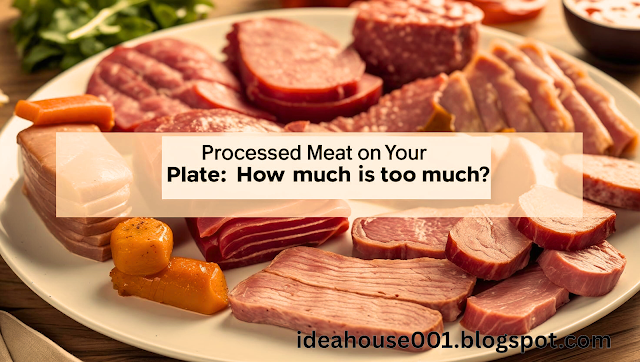Processed Meat on Your Plate: How
Much Is Too Much?
In today’s fast-paced lifestyle, convenience foods often take center stage. One such popular food choice is processed meat—bacon, sausages, ham, hot dogs, deli meats, and more. Whether in a sandwich, a breakfast platter, or a barbecue, these meats are everywhere.
But with increasing concerns about their link to health risks such as heart disease, cancer, and high blood pressure, people are now questioning:
How much processed meat is safe to eat?
Come on, we’ll break down everything you need to know about processed meat:
· What qualifies as processed meat?
· The dangers of consuming too much
· What health organizations say
· How much you can safely eat
· Smart tips to enjoy it occasionally without harming your health
Let’s explore the science in simple, understandable terms so you can make informed choices about what lands on your plate.
What is Processed Meat?
Processed meat refers to any meat that has been:
· Smoked
· Cured
· Salted
· Fermented
· Preserved with chemical additives
This includes:
· Bacon
· Ham
· Salami
· Hot dogs
· Sausages
· Beef jerky
· Canned meat
· Cold cuts (like turkey or chicken slices)
These techniques are often used to extend shelf life and enhance flavor, but they also change the nutritional and chemical makeup of the meat.
Why Is Processed Meat Considered Risky?
Many studies have linked excessive processed meat consumption to serious health issues, including:
1. Increased Cancer Risk
The World Health Organization (WHO) has classified processed meat as a Group 1 carcinogen, meaning there is strong evidence it causes cancer, especially colorectal cancer.
· Just 50 grams per day (about two slices of bacon or one hot dog) increases your colorectal cancer risk by 18%.
· This doesn't mean you will get cancer, but it does increase your long-term risk.
2. Heart Disease and Stroke
Processed meats are typically high in:
· Sodium (salt)
· Saturated fats
· Preservatives like nitrates/nitrites
These ingredients can increase:
· Blood pressure
· Cholesterol levels
· Plaque formation in arteries
All of which are major contributors to cardiovascular disease.
3. Type 2 Diabetes
Studies suggest that people who consume high amounts of processed meats have an increased risk of developing type 2 diabetes due to the chemicals used in processing and the excess salt and fat content.
How Much Is Safe to Eat?
The answer depends on your current health, dietary habits, and risk factors, but global health agencies offer some helpful guidelines:
🔹 World Health Organization (WHO):
· Recommends limiting processed meat consumption.
· 50 grams per day is already considered risky.
🔹 American Institute for Cancer Research (AICR):
· Advises to avoid processed meat altogether if possible.
· If not, limit to no more than once a week.
🔹 National Health Service (UK):
· Suggests eating no more than 70 grams of red and processed meat per day.
· That’s about 2 rashers of bacon or 1 sausage.
🔹 Harvard School of Public Health:
· Suggests no more than 1–2 servings per week of processed meat.
What Does 50 Grams Look Like?
To help you visualize, 50 grams of processed meat is approximately:
· 2 slices of bacon
· 1 hot dog
· 2 slices of ham
· 3 thin slices of salami
Eating more than this daily can start to raise serious health concerns over time.
Tips to Reduce Processed Meat Without Giving It Up Entirely
You don’t have to completely eliminate it from your life—balance is key. Here are some practical tips to help:
✅ Limit Frequency
· Aim for once or twice a week, not daily.
· Keep portions small and occasional.
✅ Choose Healthier Versions
· Look for low-sodium, nitrate-free, or organic options.
· Some brands now offer minimally processed meat.
✅ Swap With Fresh Proteins
· Replace cold cuts with grilled chicken, tuna, eggs, or legumes in sandwiches.
· Add plant-based proteins like beans, tofu, or lentils to your meals.
✅ Fill Your Plate With fiber.
· Include vegetables, whole grains, and fruits to help reduce the harmful effects.
· Fiber helps your body process and remove carcinogens more efficiently.
✅ Watch the Labels
· Avoid meats with high levels of sodium nitrate, sodium nitrite, or preservatives.
· Check serving sizes—many packs list nutritional values per 25 grams, whic
Better Alternatives to Try
If you’re craving the flavor or convenience, here are healthier
swaps:
|
Processed
Meat |
Healthier
Swap |
||
|
Bacon |
Turkey bacon, grilled mushrooms |
||
|
Ham |
Fresh turkey breast |
||
|
Sausage |
Homemade chicken sausage or tofu
sausage |
||
|
Deli meats |
Leftover roast chicken,
hard-boiled eggs |
||
|
Hot dogs |
Veggie dogs, chicken franks |
||
|
Children are more vulnerable
to salt, additives, and preservatives. For growing kids: · Avoid
daily consumption of ham or hot dogs in school lunches. · Replace
with cheese, hummus, boiled eggs, or peanut butter sandwiches. Conclusion Processed meats may taste
delicious and be convenient, but they’re not as harmless as they appear.
Health experts across the world are now in agreement — limit your
intake to stay healthy. Eating small amounts
occasionally is unlikely to cause major harm, but regular
and large servings over time can significantly increase health risks. In short: “Enjoy occasionally, avoid daily.” By making conscious choices and
balancing your plate with natural, whole foods, you can protect
your long-term health while still enjoying your favorite flavors in
moderation. Disclaimer This article is for informational
purposes only and should not be taken as medical advice. If you have specific
dietary concerns or existing health conditions, please consult a registered
dietitian or medical professional. |
|||



.png)



0 Comments